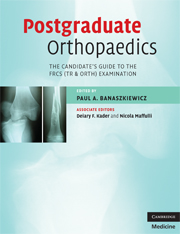Book contents
- Frontmatter
- Contents
- List of contributors
- Foreword by Mr Peter Gibson
- Preface
- Glossary
- Section 1 The FRCS (Tr & Orth) examination
- Section 2 The written paper
- 2 Written paper guidance
- Section 3 The clininicals
- Section 4 Adult elective orthopaedics oral
- Section 5 The hand oral
- Section 6 The paediatric oral
- Section 7 The trauma oral
- Section 8 The basic science oral
- Section 9 Miscellaneous topics
- Index
2 - Written paper guidance
from Section 2 - The written paper
Published online by Cambridge University Press: 22 August 2009
- Frontmatter
- Contents
- List of contributors
- Foreword by Mr Peter Gibson
- Preface
- Glossary
- Section 1 The FRCS (Tr & Orth) examination
- Section 2 The written paper
- 2 Written paper guidance
- Section 3 The clininicals
- Section 4 Adult elective orthopaedics oral
- Section 5 The hand oral
- Section 6 The paediatric oral
- Section 7 The trauma oral
- Section 8 The basic science oral
- Section 9 Miscellaneous topics
- Index
Summary
In 2006 the written paper underwent a significant change in format. Previously it was two hours long and consisted of 5 short answers or notes (60% marks) and 20 multiple choice questions (MCQs) based on the statistical analysis of a journal paper negatively marked (40% marks).
As of November 2006 the written test was composed of a combination of MCQs (single best answer, 1 from 5) and extended matching item (EMI) questions with no negative marking.
Candidates had to sit two papers. Paper 1 consisted of 120 single best answer (SBA) MCQs (2 hours) in the morning. Paper 2, sat in the afternoon, consisted of 120 EMIs and 15 MCQs relating to a published paper section (2 hours). Most candidates found that the time allowed was just about right for paper 1 but were rushed with paper 2 due to the additional time needed to read the published paper section.
The written paper continues to evolve and develop in direct response to feedback from candidates.
Paper 1 now consists of 120 MCQs (2 hours plus 15 minutes additional reading time for the published paper). The first 12 questions in the paper relate to the published paper. Paper 2 consists of 120 EMIs (2 hours).
Apparently the papers are reviewed after each sitting by the examiners and any ambiguous or inappropriate questions are removed and not scored.
Early feedback from the new trial (guinea pig) candidates is that the new format is harder to pass than the old written paper.
- Type
- Chapter
- Information
- Postgraduate OrthopaedicsThe Candidate's Guide to the FRCS (TR & Orth) Examination, pp. 9 - 10Publisher: Cambridge University PressPrint publication year: 2008



